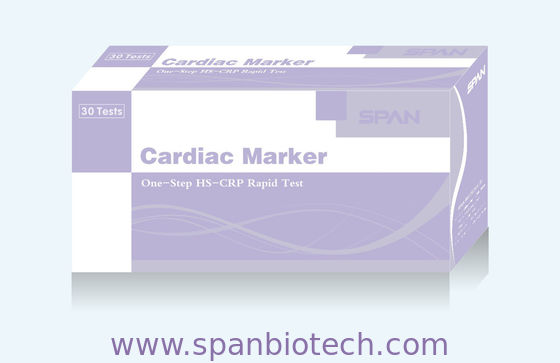|
|
HS-CRP Semi-Quantitative Rapid Diagnostic Test Uncut Sheet
|
Product Details:
Payment & Shipping Terms:
|
| Specificity: | 100% |
|---|
HS-CRP Semi-Quantitative Rapid Test Uncut Sheet
Specimens: Whole Blood/Serum/Plasma
For professional in vitro diagnostic use only.
INTENDED USE
The CrP Semi-Quantitative Rapid Test Device (Whole Blood/Serum/Plasma) is used for semi-quantitative determination and monitoring of CrP concentrations in whole blood/serum/plasma specimens.
INTRODUCTION
C-reactive Protein (CrP) in patient’s sera has been found in association with acute infections, necrotic conditions and a variety of inflammatory disorders. There is a strong correlation between serum levels of CrP and the onset of the inflammatory process. Monitoring the levels of CrP in patient’s sera indicates the effectiveness of treatment and the assessment of patient recovery. It is used in particular to differentiate bacterial infections from virus infections.
PRINCIPLE
The CrP Semi-Quantitative Rapid Test Device (Whole Blood/Serum/Plasma) is an immunochromatographic test, based on two specific antibodies against human CrP. The concentration-dependent formation of test lines allows a rapid semiquantitative determination of CrP in whole blood samples.
The tip of the test strip is dipped into the test sample which is diluted with buffer solution. The sample now moves through the test strip from bottom to top. If the test sample contains CrP, it attaches to the first anti-CrP antibody which is conjugated with a red gold colloidal for color marking. The red CrP antibody-gold complex, together with the sample liquid, diffuses through the membrane that is pre dispensed with lines of different amounts of the second anti-CrP antibody. The CrP-antibody-gold complex is immobilized by the antibodies coated on the membrane leading to the formation of red lines. The number of lines depends on the CrP concentration in the sample. The more CrP is contained in the sample, the more red lines become visible.
The control line serves as a procedural control and indicates that sufficient volume of specimen has been added and membrane wicking has occurred.
KIT COMPONENTS
|
Individually packed test devices |
Each device contains a strip with colored conjugates and reactive reagents precoated at the corresponding regions |
|
Disposable pipettes |
For adding specimens |
|
Buffer in the dilute tubes |
Phosphate buffered saline with Tween 20 and preservative |
|
Package insert |
For operating instructions
|
MATERIALS REQUIRED BUT NOT PROVIDED
|
Specimen collection container |
For specimen collection |
|
Timer |
For timing use |
|
Centrifuge |
For preparing serum/plasma specimens |
PRECAUTIONS
· For professional in vitro diagnostic use only.
· Do not use after the expiration date indicated on the package. Do not use the test if the foil pouch is damaged. Do not reuse tests.
· This kit contains products of animal origin. Certified knowledge of the origin and/or sanitary state of the animals does not completely guarantee the absence of transmissible pathogenic agents. It is therefore recommended that these products be treated as potentially infectious, and handled observing usual safety precautions (e.g., do not ingest or inhale).
· Avoid cross-contamination of specimens by using a new specimen collection container for each specimen obtained.
· Read the entire procedure carefully prior to any testing.
· Do not eat, drink or smoke in the area where the specimens and kits are handled. Handle all specimens as if they contain infectious agents. Observe established precautions against microbiological hazards throughout the procedure and follow standard procedures for proper disposal of specimens. Wear protective clothing such as laboratory coats, disposable gloves and eye protection when specimens are assayed.
· Do not interchange or mix reagents from different lots.
· Humidity and temperature can adversely affect results.
· Used testing materials should be discarded in accordance with local regulations.
STORAGE AND STABILITY
· The kit should be stored at 2-30°C until the expiry date printed on the sealed pouch.
· The test must remain in the sealed pouch until use.
Do not freeze.
· Care should be taken to protect the components of the kit from contamination. Do not use if there is evidence of microbial contamination or precipitation. Biological contamination of dispensing equipment, containers or reagents can lead to false results.
![]()
Rebecca Yan
Span Biotech Ltd.
Tel: +86(755)89589611
Cell Phone:+8618823462100(WhatsApp)
Web:www.spanbio.com
Contact Person: Ms. Anna Lee
Tel: +86-755-89589611
Fax: 86-755-89580096
-
HIV1/2/O Tri-Lines Rapid Test Uncut Sheet(WB/S/P)
-
H.Pylori Ag Feces Rapid Test Uncut Sheet (Cassette/Strip)
-
Monkeypox Virus Antigen Rapid Test Kit
-
One-Step Salbutamol Rapid Diagnostic Test Uncut Sheet
-
One-Step Malaria Pf/Pan Ag Rapid Diagnostic Test Uncut Sheet WB
-
Giardia Ag Feces Rapid Diagnostic Test




